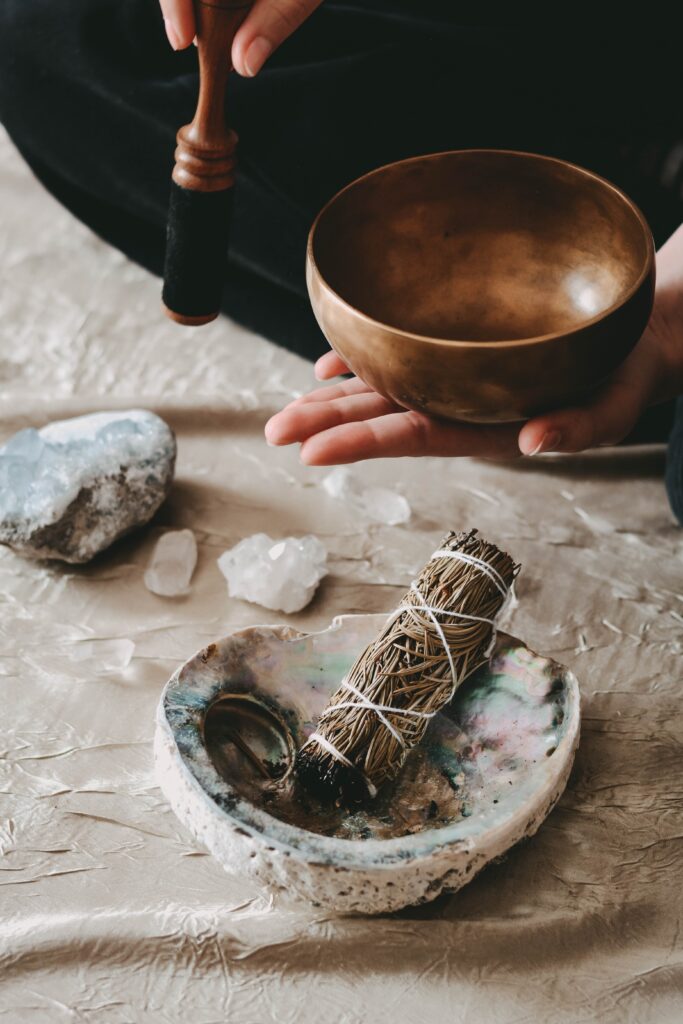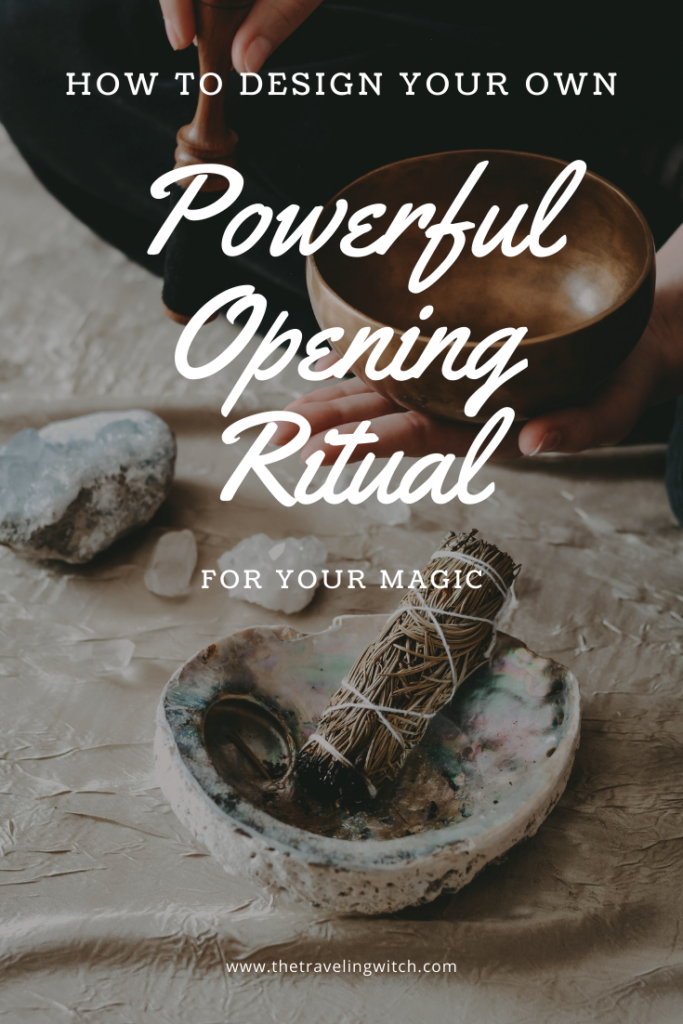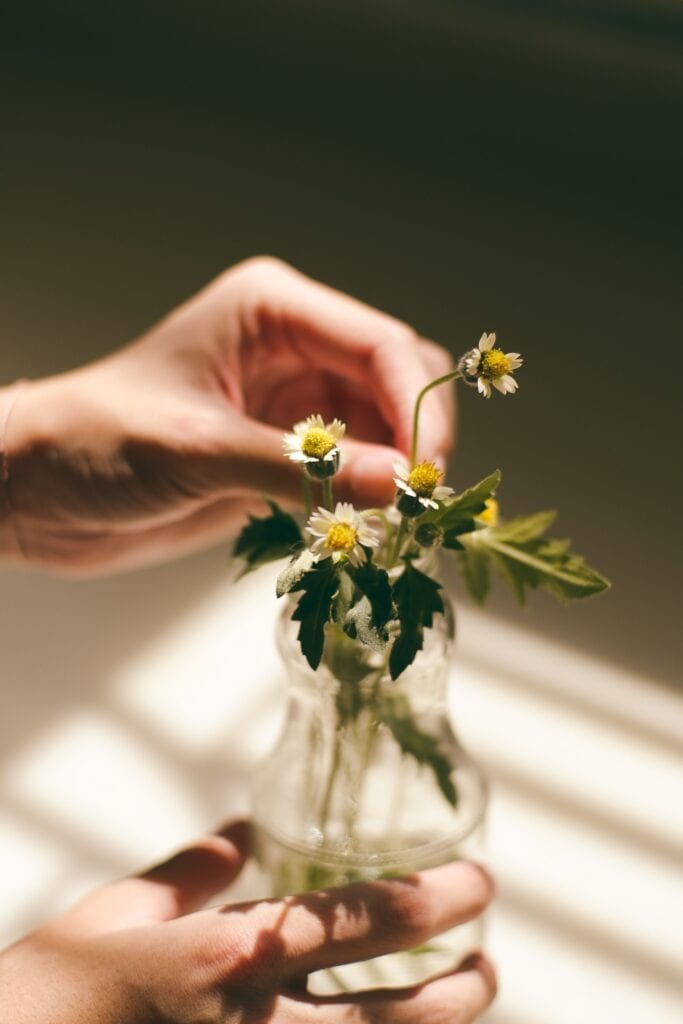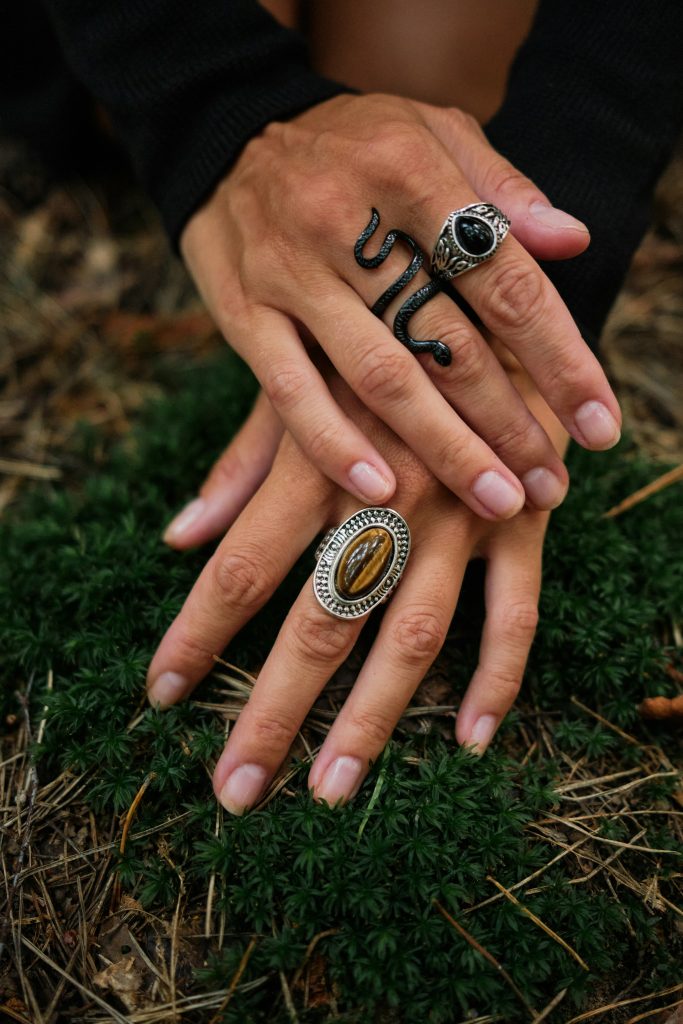There are many ways to go about beginning spells and rituals, from complex rites to simple methods such as casting a basic circle. Often there’s very little discussion of personalizing an opening rite. Instead, many of us use a preset ritual or simply follow along with whatever opening rite is included in the spell we’re currently working.

While this can and does work for many people, designing your own personalized pre-spell ritual has many benefits. As with all aspects of the craft, personalizing it to match your own beliefs and priorities allows your power to flow through the ritual more smoothly. There is no disruption from going through the motions on aspects of a ritual that seem extraneous or tedious to you.
Creating continuity and stability in your craft can also be useful. Along with allowing you to find a kind of ease in this aspect of your spell work, it can serve as a mental and energetic “trigger”. Repeating the same ritual every time you perform a spell will build a habit that will allow you to switch quickly from any mindset into your magic working mental space. For many witches, trying to perform magic when you’re “off” in some way can prove rather frustrating and giving yourself a switch can prevent these frustrations and streamline your spell work.
Defining Your Ritual
When writing any sort of personal ritual, the first thing you must do is clarify your intentions. Ask yourself, what do you want out of your pre-spell ritual? What do you need? Your ritual should not only meet your personal beliefs and sense of aesthetic but also your functional needs and style of spell casting. A poorly designed ritual will quickly become a nuisance and end up cast aside.
The first thing to consider is the desired length of your ritual. Will it need to be short and succinct so that you can perform it quickly before small spells? Or do you prefer to have more preparation and solemnity about your spell work? How long does it take you to prepare mentally to perform a spell? Keep this in mind as you assemble the pieces of your ritual, too many or too few steps and you could find yourself with a ritual that doesn’t suit your needs appropriately. If you’re unsure of what you may need in this area, start small. You can always add to your ritual as you become more comfortable with it, but starting with a mammoth of a ritual could very well end in you abandoning the ritual altogether.
In addition to the length, the complexity of your ritual should be carefully considered. Are you interested in using lengthier incantations, or will you be performing wordlessly? If you want to be able to memorize it, then you should only make it as complex as your memory will allow. If you will be performing the ritual from your grimoire every time you use it, then feel free to create something more elaborate.
Will you be needing tools for your ritual? Tools can be exceptional additions to any spell, but they can cut down on the portability and spontaneity of your spells. If you don’t often perform spells spontaneously or away from your main work space, then tools can add a more tangible feel to your ritual which many people find helpful.
How many people will be involved in your ritual? If you work alone, then this is simple and you only need to consider your own desires when building your pre-spell rite. If, on the other hand, you work in a group or coven, you may wish to consult the other members of your circle or even build this ritual with them.
Now that you have an idea of the general kind of ritual you’ll be creating, it’s time to start adding in the individual components. All the following suggestions are excellent additions to an opening rite but you can elect to use only a few of them or none at all if your imagination and inclinations draw you to some other form of ritual. These are simply some of the basic building blocks of opening a spell.
Cleansing Your Space & Self
Cleansing is a regular part of most ritual openings. It removes any stagnant, stuck, or unhelpful energies that might get in the way of your spell work, as well as ensuring that the room is properly prepared in more commonplace, earthly terms. There are two types of cleansing that should be considered for your ritual: cleansing your space and cleansing yourself.
Preparing your space may seem like a mundane task, tidying up isn’t necessarily the most magical act, but it can be incorporated into your ritual. Cleansing your workspace, both physically and energetically, can be an important first step if it isn’t something you take the time to do otherwise. Energetic cleansing removes stuck or unwanted energies from the space, ensuring a clean slate for your spells.
There are many ways to cleanse a room in this manner, for example, you could sweep your ritual space with a besom, cleanse the room with burning herbs or incense, tidy your altar, or even create a crystal grid to cleanse the room over a period of hours if you like. Other ideas include sound clearing with bells or singing bowls, visualizing white or gold light filling the space, or opening windows to allow fresh air in.
In many traditions, cleansing yourself before performing magic is an indispensable step. Smoke cleansing may also be used for this purpose but other methods to consider include ritual bathing, washing the hands, feet and/or face, changing into clothing reserved for your spell work, performing meditations, using crystals or even taking a ritual meal or drink.
Setting The Tone
This part of your ritual is largely for aesthetic purposes, but it can absolutely have an effect on your personal sense of power in your ritual. When setting the tone, there are many ways to go about achieving your desired feel; music, candles, incense, the level of lighting and the decor of the room you’re in all play a part in setting the tone for your ritual. If you aren’t picky about this sort of thing, you can eschew this step altogether or simply leave it as a blank space to be adjusted based on your current whims. If it suits your practice, you may also consider changing your ritual aesthetic based on the seasons, moon phases, or holidays.
Building energy for your spells and rituals is an act that isn’t always included, but it is one of my favorites. This step gets you thrumming with energy, unlocking channels in yourself and in your surroundings that may stay stagnant the majority of the time. In many circles, this is achieved with drumming, chanting or other kinds of music. You can also draw up energy for your rituals using dance, guided meditations, visualizations, or releasing energy from charged objects.
Consecrating
Consecration is a ritual step for religious witches. It’s the process of dedicating your tools and/or magic work space to your gods, if you have any. This process can vary greatly depending on your religious leanings and which gods you worship or work with, so I won’t be giving much detail on this. Some witches choose to consecrate once, some choose to consecrate on a regular basis (every full moon/solstice/etc) or on an as-needed basis at each ritual. If you do involve gods in your witchcraft and would like to learn more about consecrating, I would suggest looking into the specific traditions associated with your particular gods or deities.
In the same vein, invoking your gods may be an important part of an opening rite. However, if you aren’t religious, invocation may still play a part in your ritual. Often spells may include spirits or energies that need to be summoned (or perhaps politely invited) to your ritual. As an example, calling the four corners involves invoking the elemental energies of fire, air, water, and earth and their corresponding cardinal directions. If there is an energy, spirit or being that you work with regularly, this is the time to call it to your aid. Often, an offering may be appropriate as thanks.
Protecting Your Space
The act of protecting your ritual work space is perhaps considered one of the more important aspects of designing your own opening rite. Casting a circle is certainly the most commonly known form of protection, but there are many other ways to protect your ritual space.
There are many ways to cast a circle, in some methods the circle is physically drawn with salt or a cord, in others the circle is denoted with four candles or other markers denoting the cardinal directions, in some the circle is only held in the minds eye. Typically, the circle is cast by walking the perimeter clockwise three times, speaking a protective incantation or perhaps simply using your will to create a barrier against unwanted energies coming into your space. Your protective circle may also be used to keep anything in your circle from getting out, depending on what sort of magic you have planned.
Other forms of warding are equally effective. My personal preference is using a guardian to protect my space. With this form of warding, I include an offering to the guardian in my opening rite.
When deciding how to protect your ritual space, you should decide what you will need from your wards. If you are working by yourself, they can be quite simple. Working with a group may call for something more complex or even multi-layered. For example, you may wish to protect your ritual space against the emotional baggage of other members of your circle, for this you could erect a ward designed to “hold” these energies outside of the circle until the members leave again.
Another consideration is whether your wards should be permeable and to what degree. Perhaps a designated “door” in the ward might be prudent to allow members to leave for the bathroom or in the event of an emergency without breaking your circle. Would you like certain spirits, gods, or energies to be able to come and go at will? Your wards can be designed to allow this to happen.
In many practices, it’s considered an absolute necessity to ward your ritual space in some way. There are no grand rule makers in the world of witchcraft, though. You are the witch. You hold the power. You make the rules. If this practice feels too rigid, doesn’t speak to you, or doesn’t serve your personal purposes, then omit it. No one can decide what you should or should not be doing in your craft except for you.
All of these protective magics are a part of the craft known as Magical Defense. This set of skills is absolutely paramount for new witches, witches looking to take their work to the next level, and even witches who are just looking for a little more peace and quiet in their spiritual lives. The craft doesn’t have to be dangerous, stressful, or traumatic! My Defensive Magic class gives you a quick and easy to understand look at the most important magical tools and techniques for magical defense so that you can start protecting yourself. If you’re ready to stop feeling overwhelmed or scared of messing up and ending up in a sticky situation, this is for you. In this class, I’ll go over the most important parts of defending yourself magically so that you can have more space and ease in your craft. Click here to start learning how to defend yourself magically today!
When you have chosen what you wish to include in your ritual, it’s time to start fitting the pieces together. The order I have presented these ideas in is not necessarily the ideal order for your ritual. Play with your opening rite and rearrange it as you see fit. A smoothly flowing ritual is a beautiful thing and well worth the time and effort it takes to create.
Struggling with your magic?
Take the Quiz to Discover Your #1 Witchcraft Obstacle

Updated on December 5, 2024 by Avery Hart




Well written article! I agree with everything you said! I don’t normally do an elaborate opening, but this inspired me to maybe create one! The only thing I would add is that you don’t have to be religious in order to consecrate things. I’m not religious at all, but I sometimes do a ritual to consecrate objects, because psychologically, it makes them feel "holy" to me, making it more powerful to use them. Brightest blessings, and congrats on your awesome blog!
I’ve read a cople of your articles and find them very well sustained and written. I like how you take on considerations many things, mekes it seem very down-to-earth for me. I will be putting it to practice. Thank you!
I’ve found doing a quick reiki self-treatment to be a useful start for any ritual or spellwork, since it builds positive energy in and around me in a very calm sort of way. I always felt weird for not doing banishing rituals and circle castings since there is so much focus on them (especially for protective purposes), but I found they consistently gave me paranoid thoughts like was there something terrible now hovering *just outside* my “circle”? What if I didn’t “banish well enough”? Paradoxically I think it made my work less safe by putting me in a headspace of presuming negative/malefic energies. I find reiki serves the energetic and protective purposes that a lot of classic western opening rites do, but in a way that doesn’t feed my own personal anxieties.